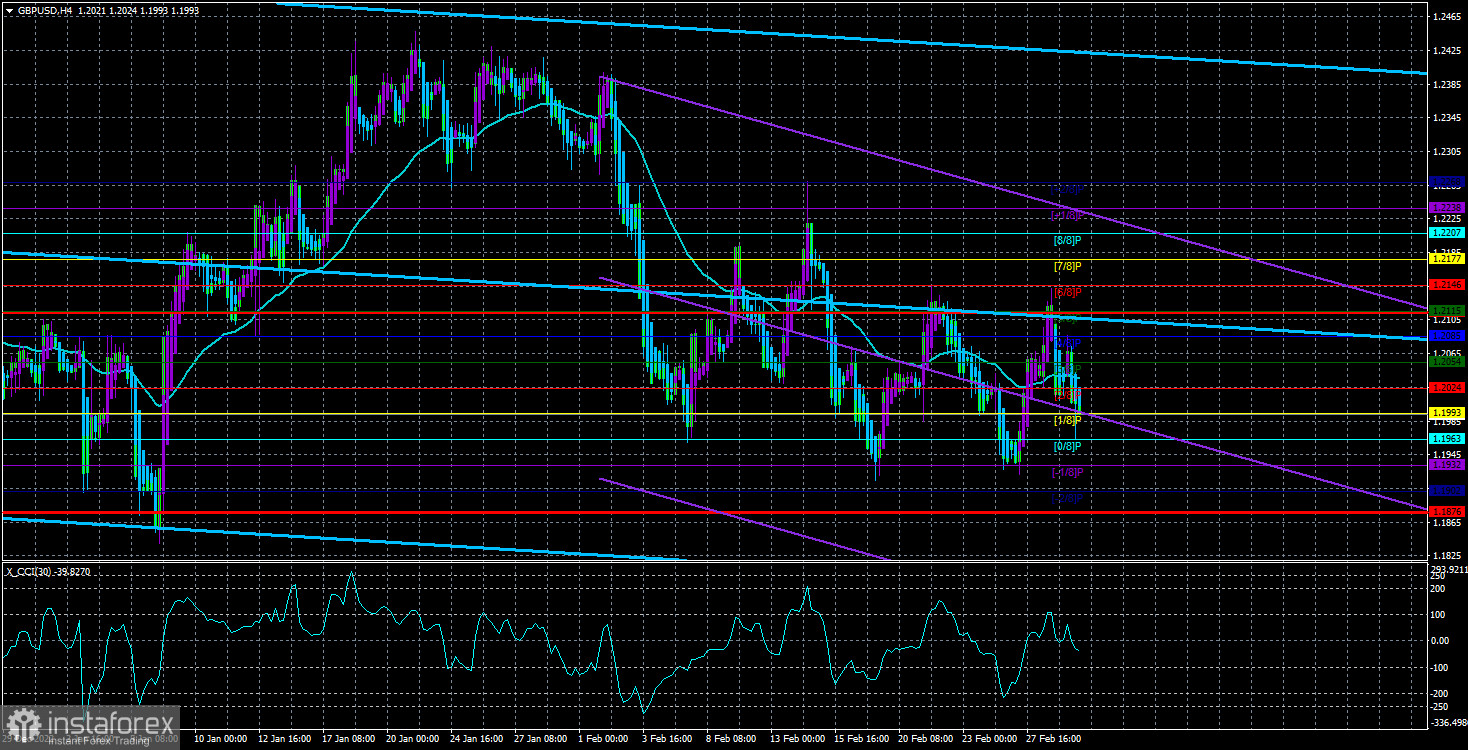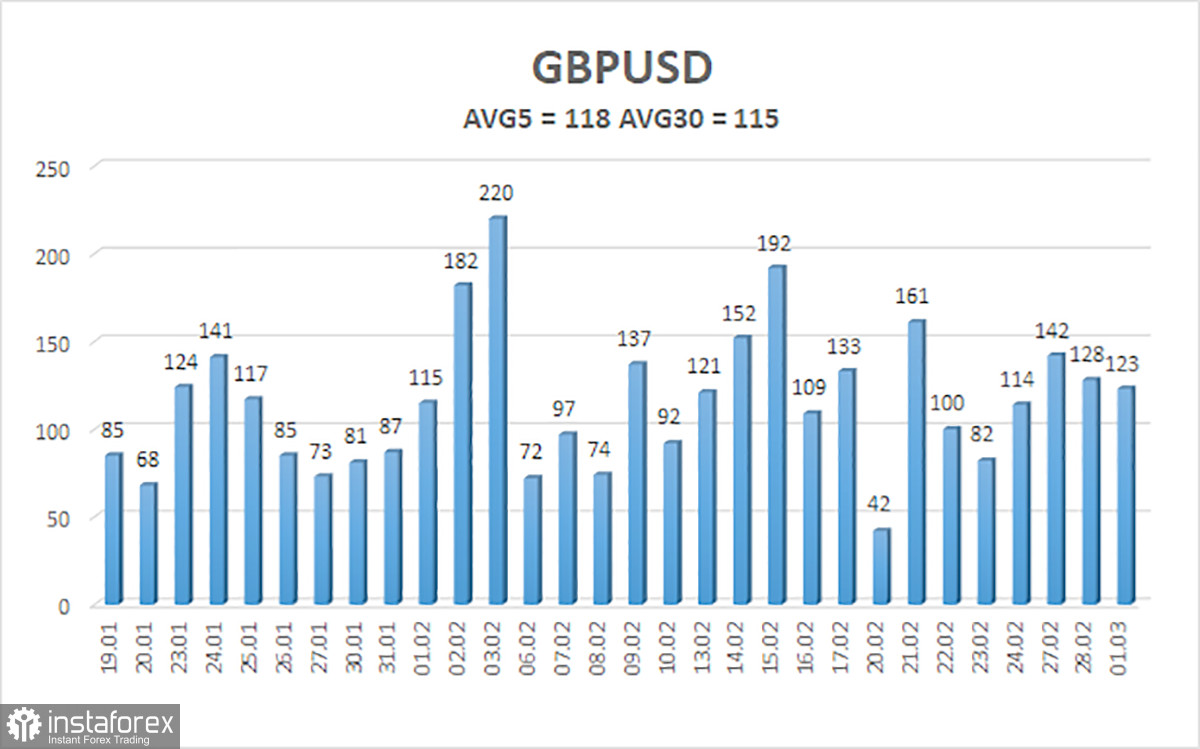
During the past few weeks, the GBP/USD currency pair has been in "swing" mode. This is readily obvious on the 4-hour TF, and on the 24-hour TF, we generally have a flat in the channel with a width of 500 points. As a result, we are now dealing with a "swing" inside a higher-order flat. Given how challenging it is to resolve frequent pair reversals, the situation is not ideal. It is advisable to trade right now on the lower timeframes because these movements appear to be fairly successful on the lower timeframes. But we also need to examine what is occurring in the older ones. At the very least, you must comprehend what is happening. This is what is now taking place. After a protracted downturn, the pair corrected by 50% and then really stopped moving. The downward correction wasn't strong enough to satisfy us. We think that the euro and the pound should keep losing ground versus the dollar. If certain growth factors begin to emerge in the case of the euro, then there are no such factors in the situation of the pound.
We've already stated in recent publications that Bank of England officials hardly ever discuss monetary policy or reveal the regulator's goals. Of course, this kind of information is occasionally obtained, but it is extremely uncommon. As a result, nobody in the market knows what to anticipate from the British regulator at this time. As a result, the pound is not increasing but neither does it tend to decrease. In general, the situation is virtually at a standstill. Moreover, we would argue that since the pair is in a flat, they still need to be able to escape, and technical considerations are now more important.
Yet, we will most likely receive some information from Andrew Bailey, who is not pessimistic. The UK's inflation rate is still not expected to fall as quickly as the regulator anticipates, and ECB official Nagel stated yesterday that the drop in energy costs did not affect the inflation slowdown. Hence, the decline in oil and gas prices may be making us wait in vain for the CPI to decline. If this is the case, lowering inflation to 2% will be even more challenging because, even at a 4% pace, it has slowed down by a total of 1%. The effects of the change in monetary policy are undoubtedly long-term, but if they were to occur at all, they would already be evident.
The Senkou Span B line is rising on its own, but the pair haven't yet been able to break out of the Ichimoku cloud on the 24-hour TF. The important level is 1.1841, which is the side channel's bottom limit.
It is unlikely that Andrew Bailey will use hawkish rhetoric.
Leading experts from across the world have already started to evaluate the speech that BA Chairman Andrew Bailey is scheduled to give this week. Commerzbank, for instance, thinks that Mr. Bailey won't set himself out with "hawkish" rhetoric and that as a result, the pound may once more experience sales. The bank thinks that a smaller-than-anticipated slowdown in the British economy could release some of the regulator's restrictions. The signature of an agreement between the EU and the UK on the "Northern Ireland Protocol" also raises certain expectations. Experts warn that this process won't completely take into account all of the effects of Brexit on the Kingdom. According to Commerzbank analysts, Bailey won't live up to the market's expectations given the rigidity of the rhetoric surrounding the rate.
We predict that BA will increase rates by 0.5% again in March before carefully considering each additional tightening. If the British regulator does not tighten monetary policy at the same rate when inflation is above 10%, it will face a barrage of criticism. As a result, we think we're in for at least one more significant rate increase. Yet once more, it's crucial to comprehend what the Fed will do in the coming months. To determine whether the January figure was an accident, you must view the next inflation report. If so, then the pound will have a significant advantage over the dollar since BA will raise the rate more quickly. If not, the pound could decline as a result of the Fed's potential decision to speed up tightening once more. Absolute "swing," in both technical and fundamental terms.

Over the previous five trading days, the GBP/USD pair has experienced an average volatility of 118 points. This value is "high" for the pound/dollar pair. As a result, on Thursday, March 2, we anticipate channel movement that is limited by the levels of 1.1876 and 1.2112. A new upward round of movement within the "swing" will be indicated by the Heiken Ashi indicator moving upward.
Nearest levels of support
S1 – 1.1993
S2 – 1.1963
S3 – 1.1932
Nearest levels of resistance
R1 – 1.2024
R2 – 1.2054
R3 – 1.2085
Trade Suggestions:
In the 4-hour timeframe, the GBP/USD pair has once again stabilized below the moving average. The pair is currently in a "swing" movement, which allows you to trade on a recovery from the levels of 1.1932 and 1.2115. Alternately, trade on the lower TF, where it is simpler to spot moves using shorter-term and more precise signals.
Explanations for the illustrations:
Determine the present trend with the use of linear regression channels. The trend is now strong if they are both moving in the same direction.
Moving average line (settings 20.0, smoothed): This indicator identifies the current short-term trend and the trading direction.
Murray levels serve as the starting point for adjustments and movements.
Based on current volatility indicators, volatility levels (red lines) represent the expected price channel in which the pair will trade the following day.
A trend reversal in the opposite direction is imminent when the CCI indicator crosses into the overbought (above +250) or oversold (below -250) zones.
 English
English 
 Русский
Русский Bahasa Indonesia
Bahasa Indonesia Bahasa Malay
Bahasa Malay ไทย
ไทย Español
Español Deutsch
Deutsch Български
Български Français
Français Tiếng Việt
Tiếng Việt 中文
中文 বাংলা
বাংলা हिन्दी
हिन्दी Čeština
Čeština Українська
Українська Română
Română

